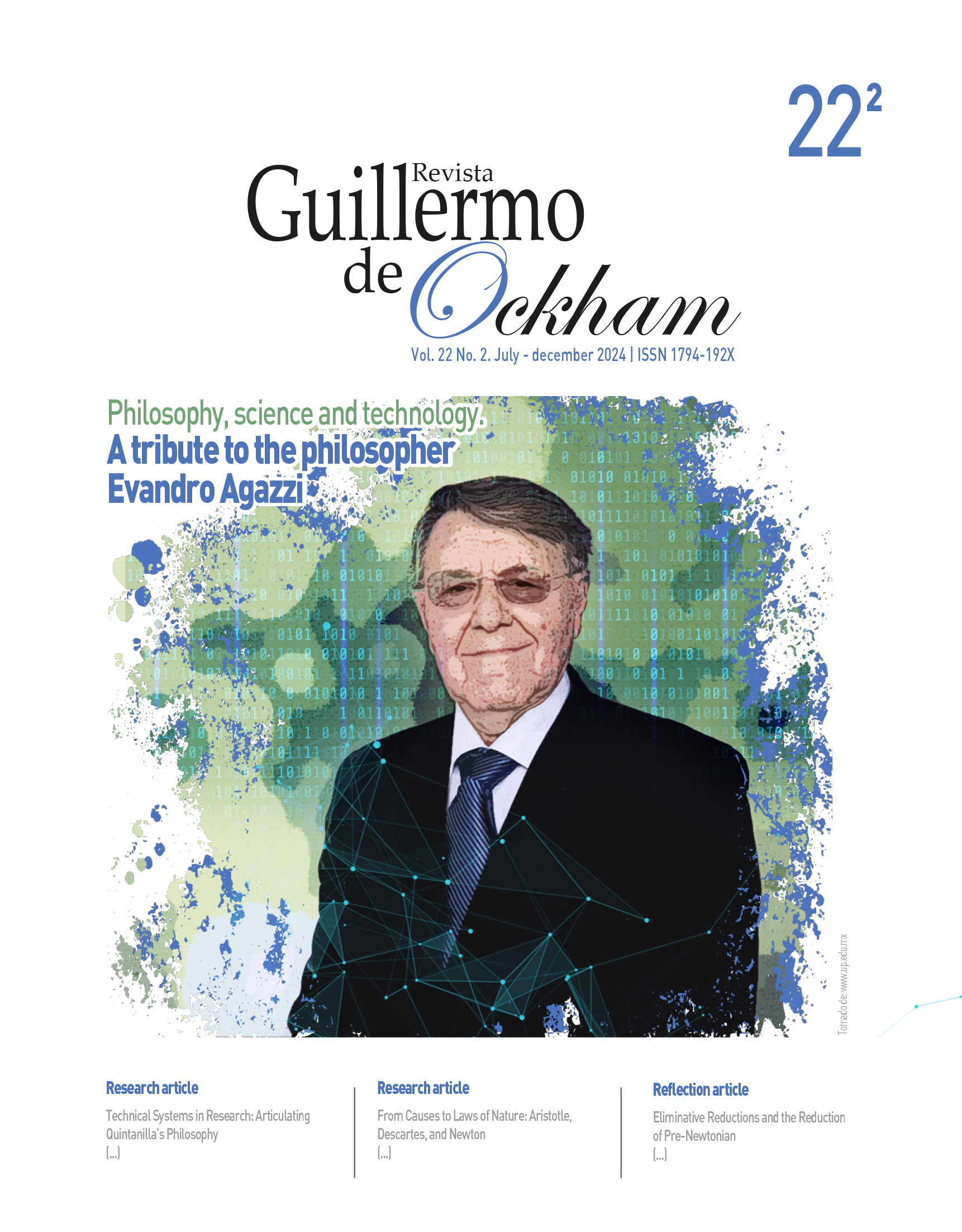The Revista Guillermo de Ockham provides an immediate and open access to its content, based on the principle of offering the public a free access to investigations to provide a global interchange of knowledge.
Unless otherwise established, the contents of this journal has a license with Creative Commons Attribution-NonCommercial-NoDerivatives 4.0 International (CC BY-NC-ND 4.0) http://creativecommons.org/licenses/by-nc-nd/4.0/
- Attribution: You must give appropriate credit, provide a link to the license, and indicate if changes were made. You may do so in any reasonable manner, but not in any way that suggests the licensor endorses you or your use.
- NonCommercial: You may not use the material for commercial purposes.
- NoDerivatives: If you remix, transform, or build upon the material, you may not distribute the modified material.
- No additional restrictions: You may not apply legal terms or technological measures that legally restrict others from doing anything the license permits.
Abstract
This paper aims to extend the conceptual framework provided by Miguel Ángel Quintanilla’s systemic philosophy of technique to account for some typical situations of scientific practice. Therefore, it seeks to harness the power of Quintanilla’s philosophical tool to achieve a form of pragmatist analysis of science, compatible with Hasok Chang’s recent epistemological proposal. To this end, Quintanilla’s framework is modified to accept epistemic artifacts and focus on epistemic activities and their difference from other kinds of actions. It is concluded that the framework holds promise for a form of epistemological analysis that transcends the emphasis on propositional knowledge (which is reduced here to the making of epistemic artifacts) so that it approaches a richer epistemology of active knowledge for thinking about scientific practice. This implies extending the analytical domain to other components of the technical systems of scientific practice, including the epistemic agent and its intentionalities and the epistemic activities it performs on the artifacts on which it operates.
Keywords:
References
Bijker, W., y Law, J. (1992). Shaping technology/building society: Studies in sociotechnical change. MIT Press.
Bridgman, P. W. (1959). The way things are. Harvard University Press.
Broncano, F. (2000). Mundos artificiales: filosofía del cambio tecnológico. Paidós.
Bunge, M. (1966). Technology as applied science. Technology and Culture, 7(3), 329-347. https://doi.org/10.2307/3101932
Bunge, M. (1977). Treatise on basic philosophy. Ontology I: The furniture of the world (Vol. 3). Reidel.
Cassini, A. (2016). Modelos científicos. En C. Vanney, I. Silva y J. Frank (Eds.), Diccionario interdisciplinario austral. https://dia.austral.edu.ar/Modelos_cient%C3%ADficos
Chang, H. (2012). Is water H2O? Evidence, realism and pluralism. Reidel.
Chang, H. (2022). Realism for realistic people: A new pragmatist philosophy of science. Cambridge University Press.
Dewey, J., y Bentley, A. (1949). Knowing and the known. Beacon Press.
Dipert, R. (1993). Artifacts, art works, and agency. Temple University Press.
Echeverría, J. (2003). La revolución tecnocientífica. FCE.
Enrríquez, A. D. (2021). Televisión, tecnología y poder: un estudio desde la filosofía de la tecnología [Tesis de maestría, Universidad Nacional de Quilmes]. RIDAA-UNQ. http://ridaa.unq.edu.ar/handle/20.500.11807/3367
Evnine, S. (2016). Making objects and events: A hylomorphic theory of artifacts, actions, and organisms. Oxford University Press.
Fleck, L. (1986). La génesis y el desarrollo del conocimiento científico. Alianza.
Frigg, R., y Hartmann, S. (2020). Models in science. En E. Zalta (Ed.), The Stanford encyclopedia of philosophy. https://plato.stanford.edu/cgi-bin/encyclopedia/archinfo.cgi?entry=models-science
Giri, L. (2017). Modelización, predicción y valores sociales. En F. Tula Molina y H. G. Giuliano (Eds.), El riesgo de que todo funcione: para una evaluación amplia de la tecnología (pp. 37-59). Nueva Librería.
Giri, L. (2020). Máquinas térmicas desde la antigüedad al siglo XVII: análisis histórico desde la filosofía de la técnica, Llull, 43(87), 29-43. https://doi.org/10.47101/llull.2020.43.87.02giri
Giri, L., y Bernabé, F. (2020). El caso de la munición expansiva: análisis de una controversia desde la filosofía de la técnica. CTS: Revista Iberoamericana de Ciencia, Tecnología y Sociedad, 15(43), 137-159. https://ojs.revistacts.net/index.php/CTS/article/view/147
Giuliano, H. G. (2006). Interrogar la tecnología. Nueva Librería.
Gómez, R. (2014). La dimensión valorativa de las ciencias: hacia una filosofía política. Universidad Nacional de Quilmes.
Hilpinen, R. (1992). Artifacts and works of art. Theoria, 58(1), 58-82. https://doi.org/10.1111/j.1755-2567.1992.tb01155.x
Hoyningen-Huene, P. (2013). Systematicity: The nature of science. Oxford University Press.
Irmak, N. (2012). Software is an abstract artifact. Grazer Philosophische Studien, 86(1), 55-72. https://doi.org/10.1163/9789401209182_005
Knuuttila, T. (2005). Models, representation and mediation. Philosophy of Science, 72(5), 1260-1271. https://doi.org/10.1086/508124
Knuuttila, T., y Voutilainen, A. (2003). A parser as an epistemic artefact: A material view in models. Philosophy of Science, 70(5), 1484-1495. https://doi.org/10.1086/377424
Kotarbinski, T. (1965). Praxiology: An introduction to the sciences of efficient action. Pergamon Press.
Kuhn, T. (1971). La estructura de las revoluciones científicas. FCE.
Latour, B. (1987). Science in action. Open University Press.
Lawler, D. (2017). La mirada praxiológica sobre la técnica. En D. Lawler, A. Vaccari y J. Blanco (Eds.), La técnica en cuestión (pp. 127-147). Teseo.
Morrison, M., y Morgan, M. (1999). Models as mediating instruments. En M. Morgan y M. Morrison (Eds.), Models as mediators (pp. 10-37). Cambridge University Press.
Niiniluoto, I. (1997). Ciencia frente a tecnología: ¿diferencia o identidad? Arbor, 157(620), 285-299. https://doi.org/10.3989/arbor.1997.i620.1818
Parselis, M. (2018). Dar sentido a la técnica: ¿pueden ser honestas las tecnologías? Los Libros de la Catarata.
Preston, B. (2022). Artifact. En E. Zalta y U. Nodelman (Eds.), The Stanford encyclopedia of philosophy. https://plato.stanford.edu/entries/artifact/
Quintanilla, M. A. (1998). Técnica y cultura. Teorema: Revista Internacional de Filosofía, 17(3), 49-69. https://www.jstor.org/stable/43047299
Quintanilla, M. A. (2005). Tecnología: un enfoque filosófico y otros ensayos en filosofía de la tecnología. FCE.
Quintanilla, M. A., y Lawler, D. (2000). El concepto de eficiencia técnica. En G. Denegri y G. Martínez (Comps.), Tópicos actuales en filosofía de la técnica: homenaje a Mario Bunge en su 80.° aniversario (pp. 203-222). Universidad Nacional de Mar del Plata.
Suárez, M. (2004). An inferential conception of scientific representation. Philosophy of Science, 71(5), 767-779. https://doi.org/10.1086/421415
Swoyer, C. (1991). Structural representation and surrogative reasoning. Synthese, 87(3), 449-508. https://doi.org/10.1007/BF00499820
Wray, K. B. (2016). Systematicity and the continuity thesis. Synthese, 196, 819-832. https://doi.org/10.1007/s11229-016-1088-y

































